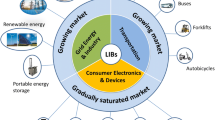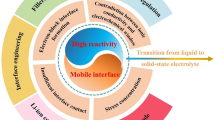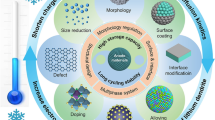Abstract
Thermal runaway of lithium-ion batteries is particularly dangerous in systems where runaway can propagate through many cells. To understand thermal runaway propagation in these systems, it is important to understand the differences between failure characteristics of the initial cell that fails due to an abuse event and subsequent cells that fail due to thermal runaway propagation. This work compares thermal runaway events for single cells failed using a heater with cells failed due to propagation in an array. Most of the tests were conducted in an inert environment within a pressure vessel. Cell clamping stress, vessel gas pressure and temperature data show that runaway in cells within an array traverses the cells more slowly and releases gas at a slower rate than singly failed cells. For heater-initiated cell failure, post-experiment cell teardowns suggest that thermal runaway originates at a single point and creates a gas flow stream that causes heavy damage and exits from one side of the cell. Teardowns of cells which failed due to array propagation show more uniform damage and gas release from a larger area.



















Similar content being viewed by others
References
Chen M et al (2015) Investigation on the thermal hazards of 18650 lithium ion batteries by fire calorimeter. J Therm Anal Calorim 122(2):755–763. https://doi.org/10.1007/s10973-015-4751-5.
Finegan DP et al (2015) In-operando high-speed tomography of lithium-ion batteries during thermal runaway. Nat Commun 6:6924. https://doi.org/10.1038/ncomms7924
Lammer M, Königseder A, Hacker V (2017) Holistic methodology for characterisation of the thermally induced failure of commercially available 18650 lithium ion cells. RSC Adv 7(39):24425–24429. https://doi.org/10.1039/c7ra02635h
Golubkov AW et al (2014) Thermal-runaway experiments on consumer Li-ion batteries with metal-oxide and olivin-type cathodes. RSC Adv 4(7):3633–3642. https://doi.org/10.1039/c3ra45748f
Liu X, Wu Z, Stoliarov SI, Denlinger M, Masias A, Snyder K (2016) Heat release during thermally-induced failure of a lithium ion battery: Impact of cathode composition. Fire Saf J 85:10–22. https://doi.org/10.1016/j.firesaf.2016.08.001
Liu X, Stoliarov SI, Denlinger M, Masias A, Snyder K (2015) Comprehensive calorimetry of the thermally-induced failure of a lithium ion battery. J Power Sources 280:516–525. https://doi.org/10.1016/j.jpowsour.2015.01.125
Feng X et al (2014) Thermal runaway features of large format prismatic lithium ion battery using extended volume accelerating rate calorimetry. Journal Power Sources 255:294–301. https://doi.org/10.1016/j.jpowsour.2014.01.005
Said AO, Lee C, Liu X, Wu Z, Stoliarov SI (2018) Simultaneous measurement of multiple thermal hazards associated with a failure of prismatic lithium ion battery. Proc Combust Inst. https://doi.org/10.1016/j.proci.2018.05.066
Wilke S, Schweitzer B, Khateeb S, Al-Hallaj S (2017) Preventing thermal runaway propagation in lithium ion battery packs using a phase change composite material: an experimental study. J Power Sources 340:51–59. https://doi.org/10.1016/j.jpowsour.2016.11.018
Lamb J, Orendorff CJ, Steele LAM, Spangler SW (2015) Failure propagation in multi-cell lithium ion batteries. J Power Sources 283:517–523. https://doi.org/10.1016/j.jpowsour.2014.10.081
Lopez CF, Jeevarajan JA, Mukherjee PP (2015) Experimental Analysis of thermal runaway and propagation in lithium-ion battery modules. J Electrochem Soc 162(9):A1905–A1915. https://doi.org/10.1149/2.0921509jes
Zhong G, Li H, Wang C, Xu K, Wang Q (2018) Experimental analysis of thermal runaway propagation risk within 18650 lithium-ion battery modules. J Electrochem Soc 165(9):A1925. https://doi.org/10.1149/2.0461809jes
Ouyang D, Liu J, Chen M, Weng J, Wang J (2018) An experimental study on the thermal failure propagation in lithium-ion battery pack. J Electrochem Soc 165(10):A2184–A2193. https://doi.org/10.1149/2.0721810jes
Ouyang D, Liu J, Chen M, Weng J, Wang J (2018) Thermal failure propagation in lithium-ion battery modules with various shapes. Appl Sci 8(8):1263. https://doi.org/10.3390/app8081263
Huang P et al (2016) Experimental and modeling analysis of thermal runaway propagation over the large format energy storage battery module with Li4Ti5O12 anode. Appl. Energy 183:659–673. https://doi.org/10.1016/j.apenergy.2016.08.160
Said AO, Lee C, Stoliarov SI, Marshall AW (2019) Comprehensive analysis of dynamics and hazards associated with cascading failure in 18650 lithium ion cell arrays. Appl Energy 248:415–428. https://doi.org/10.1016/j.apenergy.2019.04.141
Feng X et al (2015) Thermal runaway propagation model for designing a safer battery pack with 25Ah LiNixCoyMnzO2 large format lithium ion battery. Appl Energy 154:74–91. https://doi.org/10.1016/j.apenergy.2015.04.118
Feng X, Lu L, Ouyang M, Li J, He X (2016) A 3D thermal runaway propagation model for a large format lithium ion battery module. Energy 115:194–208. https://doi.org/10.1016/j.energy.2016.08.094
Li Q et al (2019) Numerical investigation of thermal runaway mitigation through a passive thermal management system. J Power Sources 429:80–88. https://doi.org/10.1016/j.jpowsour.2019.04.091
AA Portable Power Corp. Product Specification PL-896474-2C, Richmond, CA
Underwriters Laboratories (2018) Test method for evaluating thermal runaway fire propagation in battery energy storage systems, UL, UL-9540a
Wang Q, Ping P, Zhao X, Chu G, Sun J, Chen C (2012) Thermal runaway caused fire and explosion of lithium ion battery. J Power Sources 208:210–224. https://doi.org/10.1016/j.jpowsour.2012.02.038
Spotnitz R, Franklin J (2003) Abuse behavior of high-power, lithium-ion cells. J Power Sources 113(1): 81–100. https://doi.org/10.1016/s0378-7753(02)00488-3
Funding
This study was funded by the United States Department of Homeland Security, Federal Emergency Management Agency (Grant No. EMW-2016-FP-00833) and by the United States National Institute of Justice (Grant No. 2018-MU-BX-0004).
Author information
Authors and Affiliations
Corresponding author
Additional information
Publisher's Note
Springer Nature remains neutral with regard to jurisdictional claims in published maps and institutional affiliations.
Rights and permissions
About this article
Cite this article
Archibald, E., Kennedy, R., Marr, K. et al. Characterization of Thermally Induced Runaway in Pouch Cells for Propagation. Fire Technol 56, 2467–2490 (2020). https://doi.org/10.1007/s10694-020-00974-2
Received:
Accepted:
Published:
Issue Date:
DOI: https://doi.org/10.1007/s10694-020-00974-2




